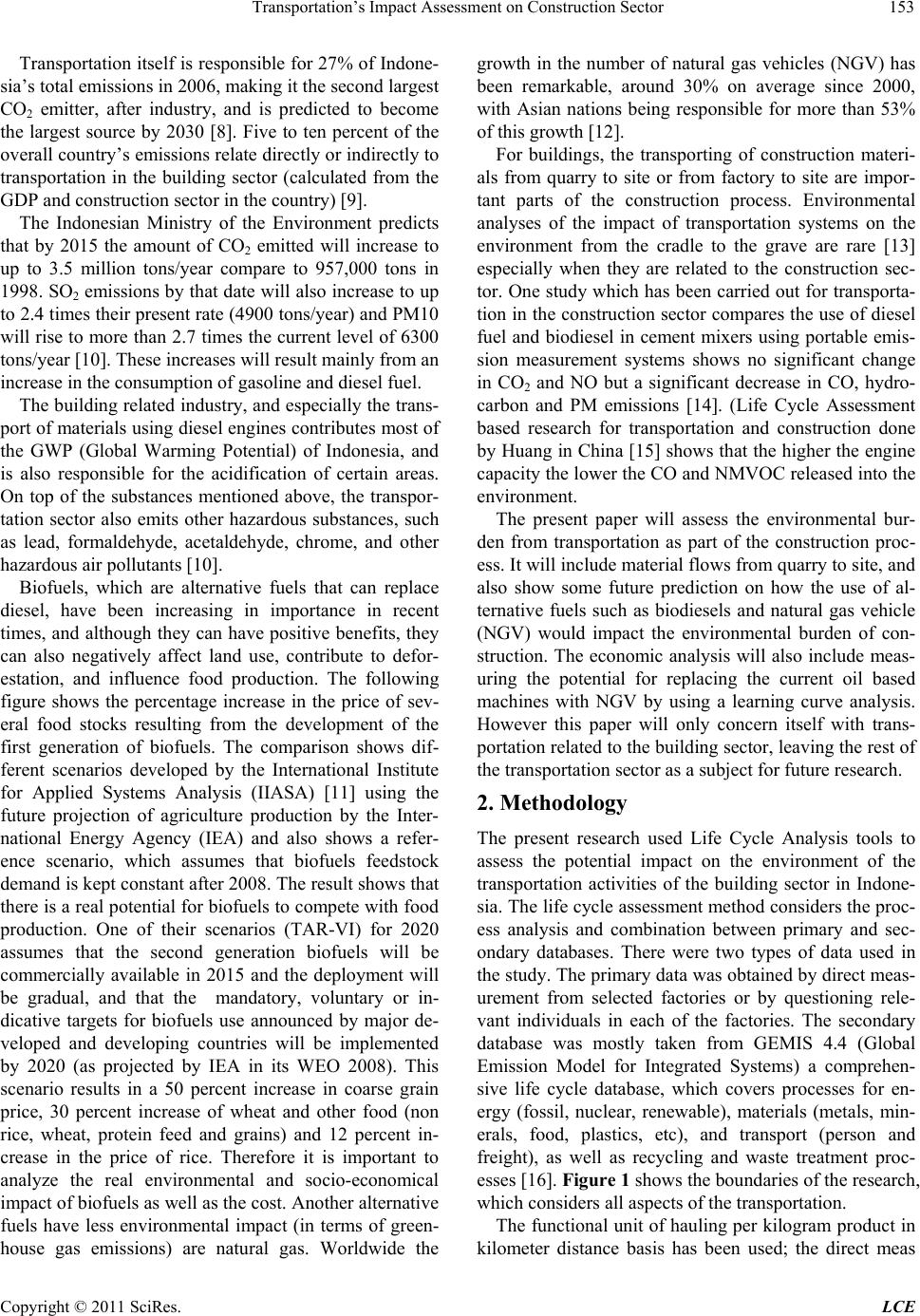
Transportation’s Impact Assessment on Construction Sector153
Transportation itself is responsible for 27% of Indone-
sia’s total emissions in 2006, making it the second larg est
CO2 emitter, after industry, and is predicted to become
the largest source by 2030 [8]. Five to ten percent of the
overall country’s emissions relate directly or indirectly to
transportation in the building sector (calculated from the
GDP and construction sector in th e country) [9].
The Indonesian Ministry of the Environment predicts
that by 2015 the amount of CO2 emitted will increase to
up to 3.5 million tons/year compare to 957,000 tons in
1998. SO2 emissions by that date will also increase to up
to 2.4 times their present rate (4900 tons/year) and PM10
will rise to more than 2.7 times the curren t level of 6300
tons/year [10]. These increases will result mainly from an
increase in the consumption of gasoline and diesel fuel.
The building related industry, and especially the trans-
port of materials using diesel engines contributes most of
the GWP (Global Warming Potential) of Indonesia, and
is also responsible for the acidification of certain areas.
On top of the substances mentioned above, the transpor-
tation sector also emits other hazardous substances, such
as lead, formaldehyde, acetaldehyde, chrome, and other
hazardous air pollutants [10].
Biofuels, which are alternative fuels that can replace
diesel, have been increasing in importance in recent
times, and although they can have positive benefits, they
can also negatively affect land use, contribute to defor-
estation, and influence food production. The following
figure shows the percentage increase in the price of sev-
eral food stocks resulting from the development of the
first generation of biofuels. The comparison shows dif-
ferent scenarios developed by the International Institute
for Applied Systems Analysis (IIASA) [11] using the
future projection of agriculture production by the Inter-
national Energy Agency (IEA) and also shows a refer-
ence scenario, which assumes that biofuels feedstock
demand is kept constant after 2008. The result shows that
there is a real potential for biofuels to compete with food
production. One of their scenarios (TAR-VI) for 2020
assumes that the second generation biofuels will be
commercially available in 2015 and the deployment will
be gradual, and that the mandatory, voluntary or in-
dicative targets for biofuels use announced by major de-
veloped and developing countries will be implemented
by 2020 (as projected by IEA in its WEO 2008). This
scenario results in a 50 percent increase in coarse grain
price, 30 percent increase of wheat and other food (non
rice, wheat, protein feed and grains) and 12 percent in-
crease in the price of rice. Therefore it is important to
analyze the real environmental and socio-economical
impact of biofuels as well as the cost. Another alternative
fuels have less environmental impact (in terms of green-
house gas emissions) are natural gas. Worldwide the
growth in the number of natural gas vehicles (NGV) has
been remarkable, around 30% on average since 2000,
with Asian nations being responsible for more than 53%
of this growth [12].
For buildings, the transporting of construction materi-
als from quarry to site or from factory to site are impor-
tant parts of the construction process. Environmental
analyses of the impact of transportation systems on the
environment from the cradle to the grave are rare [13]
especially when they are related to the construction sec-
tor. One study which has been carried out for transporta-
tion in the construc tion sector compares the use of diesel
fuel and biodiesel in cement mixers using portable emis-
sion measurement systems shows no significant change
in CO2 and NO but a significant decrease in CO, hydro-
carbon and PM emissions [14]. (Life Cycle Assessment
based research for transportation and construction done
by Huang in China [15] shows that the higher the engine
capacity the lower the CO and NMVOC released into the
environment.
The present paper will assess the environmental bur-
den from transportation as part of the construction proc-
ess. It will include material flows from quarry to site, and
also show some future prediction on how the use of al-
ternative fuels such as biodiesels and natural gas vehicle
(NGV) would impact the environmental burden of con-
struction. The economic analysis will also include meas-
uring the potential for replacing the current oil based
machines with NGV by using a learning curve analysis.
However this paper will only concern itself with trans-
portation related to the build ing sector, leaving the rest of
the transportation sector as a subject for futur e research.
2. Methodology
The present research used Life Cycle Analysis tools to
assess the potential impact on the environment of the
transportation activities of the building sector in Indone-
sia. The life cycle assessment method considers the proc-
ess analysis and combination between primary and sec-
ondary databases. There were two types of data used in
the study. The primary data was obtained by direct meas-
urement from selected factories or by questioning rele-
vant individuals in each of the factories. The secondary
database was mostly taken from GEMIS 4.4 (Global
Emission Model for Integrated Systems) a comprehen-
sive life cycle database, which covers processes for en-
ergy (fossil, nuclear, renewable), materials (metals, min-
erals, food, plastics, etc), and transport (person and
freight), as well as recycling and waste treatment proc-
esses [16]. Figure 1 shows the boundar ies of th e resear ch ,
which considers all asp ects of the transportation.
The functional unit of hauling per kilogram product in
ilometer distance basis has been used; the direct meas k
Copyright © 2011 SciRes. LCE